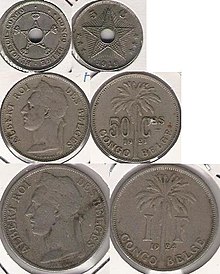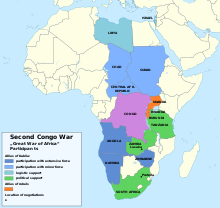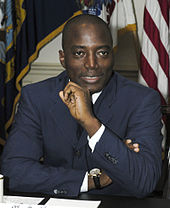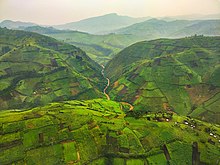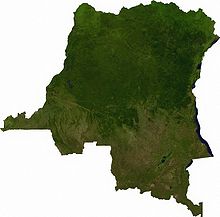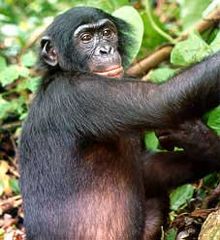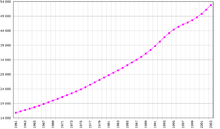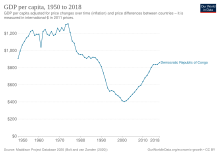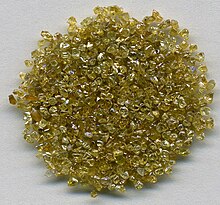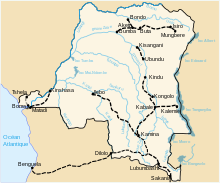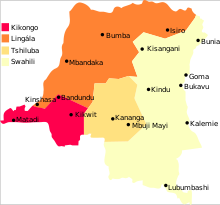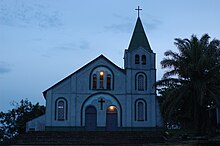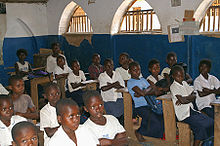Democratic Republic of Congo
The Democratic Republic of the Congo (DRC; in French, République démocratique du Congo; in Kikongo, Repubilika ya Kongo Demokratika; Swahili Jamhuri ya Kidemokrasia ya Kongo; Lingala Republiki ya Kɔ́ngɔ Demokratiki; Chiluba Ditunga día Kongu wa Mungalaata), also popularly known as R. D. Congo, Democratic Congo, Congo-Kinshasa or Eastern Congo, and called Zaire between 1971 and 1997, it is one of the fifty-four countries that make up the African continent. Its capital and most populous city is Kinshasa. The Democratic Republic of the Congo is the most populous officially French-speaking country in the world.
Situated in the equatorial region of Africa, this country comprises much of the Congo River Basin, extending into the Great Lakes region. It is the second largest country on the continent, after Algeria. It is bordered by the Central African Republic and South Sudan to the north, Uganda, Rwanda, Burundi, and Tanzania to the east, Zambia and Angola to the south, and the Republic of the Congo to the west. It has access to the sea through a narrow 37 km strip of coastline, following the Congo River to the Gulf of Guinea. The name Congo finds its origin in the Bakongo natives, settled on the banks of the Nzadi or Zaire River, renamed in Portuguese as the Congo River.
The DRC has a rich and varied history beginning with the first Bantu immigrants to arrive in the area, which would become the epicenter of the greater Kingdom of the Congo in the mid-century XV.
The territory was claimed by the International African Association (owned by King Leopold II of Belgium) as the Congo Free State. The king applied a particularly brutal colonization, which tragically left between five and ten million men, women and children murdered. The colony of the Belgian Congo would achieve independence in 1960, to become Zaire under the aegis of the dictator Mobutu Sese Seko. During the government of Sese Seko, the country was subjected to an authoritarian, violent and kleptocratic government, which ruined the economy of the Congo. The fall of the latter caused the start of a serious civil war that would degenerate into a continental conflagration, in which armed forces from more than seven countries intervened, leaving a tragic balance of more than four million dead. The result was the intervention of the UN with its peacekeeping forces organized in MONUC.
Between 2003 and 2007 the country experienced a tense calm, under the leadership of a transitional government. At the end of 2006 there were elections in which Joseph Kabila was elected president, who until then had held the functions on an interim basis.
It is on the list of megadiverse countries.
Etymology
Previously the Democratic Republic of the Congo was a colony of Belgium called the Belgian Congo, after independence the name used was the name Republic of the Congo until August 1, 1964, when its name was changed to the Democratic Republic of the Congo (to correspond to a change of constitution and to distinguish it from the neighboring Republic of the Congo). Prior to this, the two countries were distinguished by their capitals, the Democratic Republic of the Congo with Leopoldville (present-day Kinshasa), Congo-Léopoldville, and the Republic of the Congo with Brazzaville, Congo-Brazzaville. . In 1971, then-President Mobutu changed the name of the country to Republic of Zaire, a name derived from a mispronunciation in Portuguese of the Kikongo word nzere or nzadi. , which translates as "the river that swallows all rivers", alluding to the Congo River, which also changed its name to Zaire.
In the aftermath of the First Congo War that led to the overthrow of Mobutu in 1997, the country was renamed the Democratic Republic of the Congo again.
History
Old Congo
From 2000 B.C. C. to 500 d. C. massive migrations of The Bantu settled in what is now known as the Democratic Republic of the Congo (the term "Congo" is generally used to designate a region that groups together the countries and areas neighboring Congo-Brazzaville) from the northwest, adding and displacing indigenous pygmy populations to the southernmost regions of the modern state of the Democratic Republic of the Congo. Subsequent migrations from the Darfur and Kordofan regions of Sudan to the northeast, from East Africa to the east of the Congo added to the mix of ethnic groups. The Bantu imported West African agriculture and ironworking techniques into this area, establishing the Bantu language family as one of the major languages in the Congo.[citation needed]
Around the III century, a society began to develop in a region initially encompassed by an area of 200 kilometers across. along the banks of the Lualaba River in what is now the province of Katanga. This culture, known as the Upemba, eventually became the most important Luba kingdom, and the Kingdom of the Congo.
The process by which the Upemba societies transformed into the Luba Kingdom was gradual and complex. This transition proceeded without interruption, with many different societies developing out of the Upemba culture, after the rise of the Luba. Each of these kingdoms grew rich thanks to the exploitation of the region's minerals. The civilization began to develop and implement iron and copper technologies, along with trading in ivory and other goods. The Luba established a strong commercial demand for their metal technologies and were able to create an extensive trade network (the networks stretched some 1,500 kilometers, reaching the Indian Ocean). Around 1500 the kingdom had established a strong central government based on caciquismo. The Portuguese influence that radiated from the colony of Angola was very important, its kings embracing Catholicism and accepting many cultural elements. From the 17th century, after several civil wars and clashes with the Dutch and the Portuguese, it declined, although it lasted two more centuries.
The Congo Free State
The Congo Free State or Congo Independent State was an African colonial domain, privately owned by King Leopold II of Belgium, established at the Berlin Conference in 1885, whose borders coincided with the current Democratic Republic of the Congo. The Congo was privately administered by King Leopold until his death in 1908, when the territory was ceded to Belgium.
During this period, the Congo was subjected to systematic and indiscriminate exploitation of its natural resources, especially ivory and rubber, for which indigenous labor was used in slave-like conditions. To maintain its control over the native population, the colonial administration established a regime of terror, in which mass murders and mutilations were frequent, which produced a very high number of victims. Although it is impossible to make exact calculations, most authors mention figures of between five and ten million deaths.
Starting in 1900, the European and American press began reporting on the dramatic conditions in which the native population of the territory lived. Diplomatic maneuvers and the pressure of public opinion got the Belgian king to renounce his personal control over the Congo, which became a colony of Belgium, under the name of Belgian Congo.
Belgian Colonial Period (1908-1960)
Leopold II renounced these personal properties (the Congo Free State), mainly due to the international pressure he received due to the brutality with which said territory reigned, slavery, torture and crimes against humanity, complaints were filed for violations of human rights in the territories under their control.
The annexation of the territory to Belgium was formalized by means of a treaty signed on November 15, 1908, which was approved by the Belgian Parliament in August and by the King in October 1909. The colony was administered by a Governor-General based in Boma, aided by several deputy governors-general.
In Brussels there was a colonial minister who presided over the Colonial Council made up of fourteen members, of whom eight were appointed by the king, three were chosen by the Senate and another three by the Chamber of Deputies (lower house). The colony was divided into fifteen administrative districts. The colonial budget was analyzed and approved annually by the Belgian Parliament.
When the Belgian government took over the administration from King Leopold II, the situation in the Congo improved significantly, although a type of apartheid continued to be maintained legally, limiting and restricting the rights and freedoms of the Congolese, slavery and mistreatment against the population. Economic and social changes transformed Congo into what Europe called a "model colony."[citation needed] Primary and secondary schools were built, as were hospitals, and some Congolese had access to them.
Some schools taught local languages, a rarity in colonial education at the time. Doctors achieved great victories against sleeping sickness, to the point of eradicating the disease. There was a medical post in every village, and in larger cities people had access to well-equipped hospitals. The administration continued with economic reforms through the construction of railways, ports, roads, mines, plantations, and industrial areas, among others.
The Belgian administration has been characterized as paternalistic colonialism, a form of authoritarianism with sentimental elements and free concessions, such as teaching in local languages, since the system in general was dominated by the Catholic Church and, in some cases rare, by Protestant churches, but in any of them the curricula reflected the Christian religion and Belgian values. For example, in 1948, 99.6% of educational establishments were controlled by Christian missions. The education given to the natives was mainly religious. The children learned to read and write and a smattering of mathematics, but that was all. Belgian paternalism is very well represented in the Tintin in the Congo comic.
The political administration was left under the total control of the “motherland”. There were no local democratic institutions. The post of head of state was exercised by the King of Belgium, who already at that time had no political influence in the country. The Belgian government controlled the country, but day-to-day government actions were carried out by the Governor-General, who was appointed as a colonial administrator by the Belgian government.
But the paternalism of the «model colony» would have to burst. In 1952, Governor General Léon Antoine Marie Petillon wrote to the Colonial Secretary stating that if steps were not taken to improve the situation in the Congo, Belgium would lose its richest colony. He proposed granting the native population greater civil rights, including the right to vote.
The Belgian government opposed this proposal, claiming that it would "only destabilize the region." In Belgium, some deputies wanted to incorporate the Congo into the Kingdom of Belgium. In this way the Congolese natives would become Belgian citizens and thus have full civil rights in Belgium.
However, Belgium was not interested in its colony, and the government never had a long-term strategic vision for the Congo. Nevertheless, some internal political changes were introduced, but these were complicated by ethnic rivalries among the native population.
The Belgian Congo was one of the largest exporters of uranium to the United States during World War II and the Cold War, the largest amount being extracted especially from the Shinkolobwe mine.
It is noteworthy that in the 1950s forced labor, slavery and abuses still existed against the population in the Congo, and life expectancy did not reach 40 years of age.
Even so, the native Congolese had no power, everything was decided in Leopoldville and Brussels. The Belgian Congo secretariat and the Governor General, the leader of the colony, had absolute control, while the population had none. Unrest at this lack of democracy grew among the Congolese population. In 1955, the upper class of Congolese society, the so-called “évolués” (evolved) began a campaign to end injustice.
During World War II, the small Congolese army scored numerous victories against the Italians in North Africa. The Belgian Congo, which was rich in uranium deposits, supplied the material used by the United States to build the atomic bomb dropped on the Japanese town of Hiroshima, ending World War II.
Political crisis and independence
As part of the international policy of the United Nations, the end of the colonization of the nations that came to make up the so-called Third World was promoted. In the case of the Belgian possessions, the first free elections were held in 1959, which were won by the Mouvement National Congolais (MNC - Congolese National Movement), led by Patrice Lumumba.
The government of Patrice Lumumba
In 1960, Patrice Lumumba, together with the Congolese National Movement, was appointed prime minister by winning the first free legislative elections. Joseph Kasavubu, of the ABAKO (Bakongo Alliance) party, was appointed president by parliament. Other parties emerged, including the PSA or African Solidarity Party (Antoine Gizenga) and the People's National Party (Albert Delvaux, Laurent Mbariko). Barely three days after independence, the country was sinking into chaos, with revolts by the mutinous troops and the provinces of Katanga with Moise Tshombe and Kasai del Sur separated from the political alliance.
The Belgian government wanted to continue to control the country's mineral wealth and, frightened by the chaos into which it had plunged, supported the break-off of Katanga and South Kasai, where there was a large colony of Belgian citizens, supporting puppet governments in said territories. The government of Patrice Lumumba requested American help, without even being received by the US president, which led to a rapprochement with the Soviet sphere, which provided transportation and military advisers in order to intervene in the separatist provinces. Lumumba repeatedly denied having any communist ideology.
Subsequent events led to a crisis between the president and the prime minister, culminating on September 5, 1960, when Prime Minister Lumumba was ousted by President Kasavubu. The United Nations sent troops that imprisoned Lumumba, who was finally captured by the rebels, taken to Katanga and shot on January 17, 1961 with the direct intervention of agents of the Belgian government and the CIA. His mortal remains were burned.International troops, with US support, fought the secessionists and precariously restored the unity of the country.
Even so, widespread confusion remained. Several governments were led by technicians from the College of Commissioners; Joseph Iléo, Cyrille Adoula, Moise Tshombe and Evariste Kimba following one another in a short time.
The most serious crisis occurred in the spring of 1964 when former supporters of Patrice Lumumba, with a strong tribal presence, staged a major revolt. They quickly seized the north of the country, wiping out demoralized government troops. After the pro-Western Moise Tshombe was appointed Prime Minister, the United States and Belgium supported the central government, sending numerous weapons. Likewise, a thousand mercenaries were hired and in autumn most of the territory was recovered. Cornered in Stanleyville, the rebels tried to play their last card, some two thousand Western hostages.
Faced with this situation, on November 24, 1964, Belgian paratroopers, who had counted on American logistical support for transport, took the airport by surprise first and then the rest of the city, freeing most of the white citizens, except about thirty who died initially. In the following weeks the number exceeded one hundred, including numerous nuns and missionaries, both Catholic and Protestant, among other Christian-phobic acts. Likewise, tens of thousands of Congolese were massacred by the guerrillas. The press of the time includes references to torture, dismemberment and even cannibalism.
This intervention provoked numerous protests in African countries, which led to the Belgian troops withdrawing in the first days of December, once the objective of saving most of the Western hostages had been achieved. From that moment on, the leading role fell to the native troops, who, under the direction of white mercenaries, little by little cornered the rebels.
Mobutu's dictatorship
After five years of extreme instability and civil unrest, the military man Joseph-Désiré Mobutu, now a lieutenant general, supported by the CIA, overthrew Kasavubu in a coup in 1965, a one-party political system was established, and Mobutu proclaimed himself head of state. He occasionally called elections where he was the only candidate.
The country enjoyed relative stability, but the government of the dictator Mobutu was accused of human rights violations, repression, cult of personality (every Congolese banknote carried his image, his portrait was posted on all public buildings, in many businesses and on billboards, and it was common for ordinary people to dress in their likeness) and extreme corruption; in 1984 Mobutu was said to have US$4 billion, an amount similar to the national debt, in his Swiss bank accounts. To stoke Africanist sentiment, he began on June 1, 1966, to rename the nation's cities: Léopoldville became Kinshasa (the country was known as the Democratic Republic of the Congo-Kinshasa), Stanleyville was renamed Kisangani, and Elisabethville was renamed Lumbumbashi.. The city renaming campaign was completed in the 1970s. In 1971 he renamed the country the Republic of Zaire (the fourth name change in eleven years and the sixth overall), the Congo River became on the Zaire River and the following year Mobutu changed his name to Mobutu Sese Seko.
As the Soviet Union fell, relations with the United States cooled, Mobutu was no longer a necessary ally in the Cold War, and his opponents inside Zaire stepped in by demanding reforms to the political system. This atmosphere contributed to Mobutu's declaration of the "Third Republic" in 1990, the constitution of which would be a step towards democratization. The reforms turned out to be merely superficial and Mobutu continued to rule.
Conflict and transition
- See: First Congo War, Second Congo War, Ituri conflict and DRC transitional government.
In the mid-1990s the situation took a radical turn for the worse. Within the framework of the Great Lakes refugee crisis, the Rwandan genocide led to an avalanche of refugees fleeing the war in Rwanda and Burundi. Mobutu's inability to handle this crisis, coupled with the loss of support from the West, allowed his opponents to launch a major campaign against him that ended with his flight and the proclamation by rebel leader Laurent-Désiré Kabila of the Republic. Congo, in May 1997. But Kabila's allies soon turned against him and his regime was challenged by a rebellion backed by Rwanda and Uganda in August 1998. Troops from Zimbabwe, Angola, Namibia, Chad and Sudan intervened. to support the new regime in Kinshasa, starting a devastating war known as the "Second Congo War" o African World War, the conflict that has cost the most lives in the world since the end of the Second World War.
A ceasefire was declared on July 10, 1999; Even so, the fight continues to gain strength, especially in the eastern part of the country, financed by the income from the illegal extraction of minerals such as coltan, cassiterite and diamond. Kabila was assassinated in January 2001 and his son Joseph Kabila was appointed Head of State. The new president quickly began negotiations to end the war, and the Pretoria Agreement was signed in South Africa in 2002. As of late 2003, a fragile peace has prevailed since the transitional government was installed. Kabila appointed four vice presidents, two of whom had fought to oust him since July 2003. Much of the eastern part of the country remains insecure, mainly due to the Ituri conflict and continued activities by the Democratic Forces to the liberation of Rwanda in the provinces of North Kivu and South Kivu.
On July 30, 2006, the country's first free multi-party elections since independence in 1960 were held. Joseph Kabila obtained 45% of the vote in the first round and his opponent and former vice president Jean-Pierre Bemba 20 %. This gave rise to clashes from August 20 to 22 between supporters of the two candidates in the streets of the capital, Kinshasa. 16 people are killed until EUFOR and MONUC forces regain control of the situation. The second round of the elections is held on October 29 and in it President Kabila manages to be re-elected.
Coltan leaves the mines to key trading posts, where it is purchased by foreign merchants who ship it abroad, mainly through Rwanda. Technologically savvy companies turn coltan into the coveted tantalum powder, then resell it to tech multinationals such as Nokia, Motorola, Compaq, Sony and other manufacturers, who use it in mobile phones and other electronics.
In 1996, the US sponsored an invasion of Rwandan and Ugandan military forces into eastern DRC. Around 1998 they took control and occupied the strategic mining areas. Soon enough, the Rwandan army began making more than $20 million a month from coltan mining. Although its price has fallen, Rwanda maintains the DRC's monopoly on the exploitation and trade of the metal. There is a barrage of reports of rampant human rights abuses in that mining region.
Health problems
Starting in 1976 in the Democratic Republic of the Congo, a disease appeared that would threaten the country, Ebola, which is still present until today. A disease characterized by causing bleeding 48 hours after acquiring the infection. This disease, which is transmitted by saliva and body fluids, can cause death in 21 days. There is no cure or vaccine and it is a disease that is proportionally much more lethal in those affected than HIV/AIDS. In 2016, all the Congolese provinces bordering Angola were affected by the yellow fever outbreak in the neighboring country.
Politics and Government
The recent history of this African nation has not allowed for very advanced political development, since armed conflicts and dictatorships have dominated the panorama since independence in the 1960s. However, once the Second Congo War ended Great efforts have been made to stabilize and provide the ill-fated country with a democratic political system that gives the population the necessary stability to promote peace, reconciliation and economic development.
As part of the Lusaka Agreements and the Pretoria Treaty, in 2005 the country promulgated a new Political Constitution in which the system was largely reorganized public and state administration. The provinces went from 10 to 25, a bicameral Parliament (consisting of the Senate and a National Assembly) and an embryonic structure of a new judicial power were established. All the provisions of this legal text have various deadlines for entry into force, estimating that said process concludes by the end of the 2010s.
After decades of dictatorships, wars and conflicts, the Democratic Republic of the Congo saw the first elections in its history in the middle of this decade. The purpose of the elections was to approve the new Constitution of the country (2005), elections for the president and members of the National Assembly (2006), governors of the provinces and members of the Senate (2007).
Since January 2019, the current president of the country is Félix Tshisekedi who replaced Joseph Kabila after winning the 2018 elections.
Defense
The Military Forces of the Democratic Republic of the Congo is the state agency responsible for the defense of the Democratic Republic of the Congo. The FMRDC is being rebuilt as part of the peace process that followed the end of the Second Congo War in July 2003.
Most of the FMRDC members are ground forces, but they also have a small air force, and an even smaller navy. Together, the three services count between 144,000 and 159,000 people. In addition, there is a presidential force called the Republican Guard, but the Congolese National Police (PNC) is no longer part of the Armed Forces.
Corruption
Mobutu Sese Seko ruled the Democratic Republic of Congo, which he renamed Zaire, from 1965 until 1997. The current government explained how the Zaire government illegally collected revenue from the nation, they put it like this: "Mobutu would ask one of us to go to the Bank and take out 1 million". Mobutu allowed corruption in the state to prevent his political rivals from challenging his control, leading to an economic collapse in 1996.
Mobutu reportedly stole 4 or 5 billion dollars; In July 2009, a Swiss court found that the statute of limitations had run out on an international asset recovery case involving some $6.7 million of Mobutu's deposits in a Swiss bank, and therefore the assets must be returned to Mobutu's family.
President Joseph Kabila established the Commission for the Suppression of Economic Crimes upon his rise to power in 2001.
Territorial organization
Since the country's independence, the D.R.C. it was traditionally divided into ten provinces. These were of different sizes and historically constituted in themselves foci of secessionism in response to the little force of the Kinshasa government to maintain control throughout the country. Thus, for example, in the 1960s the state of Katanga declared its independence, although this situation was later reversed. The 2005 Constitution established a change in the territorial organization of the Congo, creating 26 provinces to replace the traditional 10. These, according to the constitutional text, began to function in February 2009.
| N.o | New province | Capital | Antigua province |
|---|---|---|---|
| 1 | Kinsasa | Kinsasa | No change |
| 2 | Central Congo | Matadi | Under Congo |
| 3 | Kwango | Kenge | Bandundu |
| 4 | Kwilu | Kikwit | Bandundu |
| 5 | Mai-Ndombe | Inongo | Bandundu |
| 6 | Kasai | Luebo | West Kasai |
| 7 | Kasai Central | Kananga | West Kasai |
| 8 | East Kasai | Mbuji-Mayi | East Kasai |
| 9 | Lomami | Kabinda | East Kasai |
| 10 | Sankuru | Lodja | East Kasai |
| 11 | Maniema | Kindu | No change |
| 12 | South Kivu | Bukavu | No change |
| 13 | North Kivu | Goma | No change |
| 14 | Ituri | Bunia | East |
| 15 | Alto Uele | Isiro | East |
| 16 | Tshopo | Kisangani | East |
| 17 | Under Uele | Buta | East |
| 18 | North Ubangi | Gbadolite | Ecuador |
| 19 | Mongala | Lisala | Ecuador |
| 20 | South Ubangi | Gemena | Ecuador |
| 21 | Équateur | Mbandaka | Ecuador |
| 22 | Tshuapa | Boende | Ecuador |
| 23 | Tanganica | Kalemie | Katanga |
| 24 | Alto Lomami | Kamina | Katanga |
| 25 | Lualaba | Kolwezi | Katanga |
| 26 | Alto Katanga | Lubumbashi | Katanga |
Foreign Relations
Global growth in demand for scarce raw materials and industrial booms in China, India, Russia, Brazil, and other developing countries require developed countries to employ new, integrated, and responsive strategies to identify and secure, on an ongoing basis, an adequate supply of strategic and critical materials necessary for its security needs. Highlighting the importance of the DR Congo to US national security, the effort to establish an elite Congolese unit is the latest push for United States to professionalize the armed forces in this strategically important region.
There are economic and strategic incentives to bring more security to Congo, which is rich in natural resources such as cobalt, a strategic and critical metal used in many industrial and military applications. The largest use of cobalt is in superalloys, used to make parts for jet engines. Cobalt is also used in magnetic alloys and in cutting and wear-resistant materials such as cemented carbides. The chemical industry consumes significant amounts of cobalt in various applications, such as catalysts for petroleum and chemical processing; drying agents for paints and inks; base coats for porcelain enamels; bleach for ceramics and glass; and pigments for ceramics, paints and plastics. The country holds 80% of the world's cobalt reserves.
It is believed that due to the importance of cobalt for electric vehicle batteries and the stabilization of electricity grids with large shares of intermittent renewables in the electricity mix, the DRC could become the subject of further geopolitical competition.
In the 21st century, Chinese investment in the DRC and Congolese exports to China have grown rapidly. In July 2019, UN ambassadors from 37 countries, including the DRC, signed a joint letter to the UNHRC defending China's treatment of Uyghurs and other Muslim ethnic minorities. In 2021, President Félix Tshisekedi called for a review of the mining contracts signed with China by his predecessor Joseph Kabila, in particular the multi-billion dollar "minerals for infrastructures" of Sicomines.
Geography
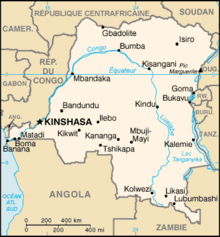
Goma
Ilebo (Port-Francqui)
Kalemie (Albertville - Albertstad)
Kananga (Lualabourg - Lualaburg)
Kindu
Kinsasa (Léopoldville - Leopoldstad)
Kisangani (Stanleyville - Stanleystad)
Kolwezi
Likasi (Jadotville - Jadotstad)
Lubumbashi (Elisabethville - Elisabethstad)
Mbandaka (Coquilhatville - Cocquilhatstad)
Mobaye-Mbongo (Banzyville - Banzystad)
The Democratic Republic of the Congo lies in the heart of western-central sub-Saharan Africa and is bordered (clockwise from the west) by Angola, the Republic of the Congo, the Central African Republic, South Sudan, Uganda, Rwanda, Burundi, Tanzania (bordering Lake Tanganyika) and Zambia. The territory is crossed by the equator, with a third country in the Northern Hemisphere and two thirds in the Southern Hemisphere
As a result of its equatorial location, the DR Congo. It has very high rainfall rates (See Rainforest), the country's annual average is 1,070 mm. All this rain creates the Congo Jungle, the second largest in the world. Lush vegetation covers much of the river's basin, all the way to its mouth in the Atlantic to the west. This area is bordered by savannas to the south and southwest, by mountainous terrain to the west, and dense grasslands extending beyond the Congo River to the north. High mountains can be found in the easternmost region of the country, with the country's highest point being Mount Ngaliema on the border with Uganda (5,110 meters).
The Congo River Basin covers almost the entire country, covering an area of nearly 3,700,000 km². The river and its tributaries (The Kasai, Sangha, Ubangui, Aruwimi, and Lulonga are the largest) form the cornerstone of the economy and transportation, and have a high impact on the daily life of the population. The source of the Congo is found in the highlands and mountains of the Great Rift Valley, also in Lake Tanganyika and Lake Mweru. The Congo River is the longest in Central Africa, the second longest in Africa, it is also the second largest in the world.
The Great Rift Valley of the African continent encompasses the area of the African Great Lakes with which the DR Congo, the country adjoins two of these: Lake Albert and Lake Tanganyika. The Rift Valley has endowed most of the southern and eastern DR Congo. with a large amount of mineral wealth. Including coltan (a mineral that has helped finance various sides in the Second Congo War, a conflict that has resulted in an approximate death toll of more than 5 million, the highest since the Second World War), cobalt, copper, cadmium, petroleum, diamond, gold, silver, zinc, magnesium, tin, germanium, uranium, radium, bauxite, iron and coal. Unfortunately, this wealth has not been able to be enjoyed by the people of the DR Congo, on the contrary, the local guerrillas finance themselves in part thanks to the exploitation and sale of illegally stolen diamonds.
| Northwest: | North: | Northeast: |
| West: |  | This: |
| Southwest: | South: | Sureste: |
Flora and fauna
Located in a territory of diverse orography, the DR Congo has a great variety of biomes; from the savannah in the southern regions, the montane jungle of the mountainous regions of the east, the great African lakes to the east and the jungle of the Congo, D.R., which is, after the Amazon Jungle, the largest in the world, this makes the DR Congo one of the countries with the greatest biological diversity on the planet.
WWF divides the territory of the DR Congo into sixteen ecoregions:
- Mosaic of jungle and savannah in the north of the Congo.
- East Sudanese savanna, northeast.
- Atlantic equatorial coastal jungle, at the west end.
- Mangrove Central Africa, in the mouths of the Congo River.
- North-Eastern Congo Basin Jungle, north-east of the Congo Basin.
- Banana Jungle of the Western Congo, on the western shore of the Congo.
- East Congo swamp forest on the eastern shore of the Congo.
- Selva de tierras baja del Congo central, en el centro de la Cuenca del Congo.
- Mosaic of jungle and savannah of the western Congo.
- Mosaic of jungle and savannah of southern Congo, in the south of the Congo basin.
- Mounted jungle of the Albertina fault and paraamo of the Ruwenzori and Virunga mountains in the eastern mountains.
- Mosaic of jungle and savannah of Lake Victoria Basin on the border with Uganda.
- Treeed savannah of miombo from Angola, in the southwest.
- Treeed savannah of central Zambeze miombo, southeast.
- Matorral de Itigi and Sumbu, in a small enclave next to Lake Tanganica, on the border with Zambia.
- Zambeze's flooded mountain range, in a small area of the southeast, on the border with Zambia.
Among the many species (some endemic and many others rare) that inhabit its territory we can find: two species of chimpanzees; the common chimpanzee and the bonobo or dwarf chimpanzee; the mountain gorilla; the okapi and the Congo peafowl. Five of the country's national parks are listed as World Heritage Sites: Garamba, Kahuzi-Biega, Salonga, Virunga National Parks and the Okapi Wildlife Reserve. The civil war and the impoverished economy have greatly damaged biodiversity. Many park rangers were killed or unable to continue their work. These five sites are listed as World Heritage Sites in danger by Unesco.
Over the centuries, the DR Congo has been at the center of Central African bushmeat trafficking, which is considered by many to be an environmental problem, and part of the country's socio-economic crisis. The meat of the wild animals that are trafficked is generally obtained through wire trap-cages, other times with shotguns or weapons originally obtained from the numerous military conflicts in the DR Congo.
Climate
Due to its geographical location, the Democratic Republic of the Congo has an equatorial climate. For this reason, most of the country has a very hot humid tropical climate, with an average temperature of about 20 °C in the dry season and about 30 °C in the rainy season. The climate is relatively little influenced by seasons such as dry and rainy. However, there are regional disparities due to the large size of the country.
The equator runs through the north-central part of the country, where the cities of Mbandaka and Kisangani meet. This area, about 300 kilometers wide, receives abundant rainfall throughout the year, with an average of 1,500-2,000 mm, while the temperature remains constant at around 26 °C.
Kinshasa's climate is characterized by an average annual temperature above 25°C and an alternation between the dry (four months in total) and rainy seasons, peaking in November and April. In the whole year, Kinshasa receives a total of about 1,400 mm of rain.
In the north of the country, the large amount of forest, typical of the equatorial climate, gives way to a wooded savannah. There, unlike in the south, the dry season usually begins two or three months before the turn of the year and ends about two or three months after the turn of the year. Therefore, about 90% of the annual rainfall falls here in the period between March and November.
A tropical climate zone begins in the south, with well-differentiated seasons: a dry season (from three to six months, especially from May to September) and a rainy season (from six to nine months, especially from October to April). For example, Lubumbashi, in the Haut-Katanga province, has up to six months of relative drought and very pronounced temperature fluctuations between day and night.
The mountainous eastern part of the country is characterized by a high-altitude climate and is considerably cooler than other areas. Since the temperature drops there by an average of 1 °C for every 80 meters of altitude, there are notable climatic and ecological differences in the ascent of the mountains of the Virunga National Park and the slopes of the Ruwenzori Mountains. At the highest points of these areas, even snowfall is not uncommon. This is also where most of the country's rainfall falls.
In the small coastal area in the far west, where the Congo River also empties, the cold Benguela Current greatly reduces temperature and rainfall, so that the city of Boma, for example, receives less than 800mm of rainfall on average per year. year.
Relief
The center of the Democratic Republic of the Congo is a vast alluvial basin that covers about a third of the territory, with an altitude between 300 and 500 meters. Its vegetation is made up of equatorial forests and swamps. The Congo River Basin has a dense hydrographic network and large alluvial plains. A steady slope leads north and east to the plateaus punctuated by the deep valleys of the Oubangui, Uele, Lukénié and Lasaï rivers (1,000 m) and west to the Batéké and Lunda plateaus (1,200 m). On the eastern border, the great fissures occupied by the Tanganyika, Kivu, Edouard and Albert lakes are dominated by granitic poles (Rwenzori, 5,109 meters) and volcanic formations (Virunga chain), including the active volcano Nyiragongo (3,470 meters). To the southeast stretch highlands dotted with inselbergs (Katanga Plateau), massifs with flattened peaks (Mitumba Mountains) and sinkholes (Lake Upemba). To the west, a narrow sandy and sometimes marshy strip offers access to the Atlantic.
Environmental issues
Deforestation is intense in the Democratic Republic of the Congo. According to Greenpeace projections (2017), the country could have lost 40% of its forests by 2050, despite having received hundreds of millions of euros in public funds from international donors to protect this important ecological heritage in the context of war of the beginning of the 21st century, in exchange for a moratorium on the granting of new logging titles.
This moratorium, established in 2002, has slowed deforestation for nearly 20 years, but it hasn't stopped it. Greenpeace has denounced several violations of the moratorium: in the weeks following its signing, numerous illegal titles were distributed, then a presidential decree in 2005 reinforced the 2002 decree, but 15 titles canceled in 2009 as a result of this decree were reinstated in 2011, then three forest concessions were illegally assigned again in 2015 to two companies: FODECO and SOMIFOR created by mostly Chinese investors and registered in Kinshasa at the same address (in Limete), and were created by Chinese investors), in 2020, 1.4 million hectares of so-called "conservation" were offered to mining interests.
According to Rainforest, Claude Nyamugabo (Bazaiba's predecessor) awarded more than four million hectares of illegal concessions23. Then, in 2021, the government plans to lift the moratorium, to satisfy the timber and exotic wood industry. This worries the international community and NGOs such as Greenpeace and Rainforest, since this type of situation always triggers a "cascading deforestation" almost impossible to stop. According to the Save the Forest Network (2021), "opening millions of hectares of virgin forest to industrial exploitation would be an absolute disaster for the climate, biodiversity, the rule of law and the human rights of forest communities". According to NGOs, this could triple the area of logging where "thousands of local communities and indigenous peoples live" and "endangered species"; more than one million hectares are peat forests, the felling of which could release more than 10 billion tons of carbon dioxide.
Demographics
In 2007, the Democratic Republic of the Congo had a population of 65,750,000. The average number of children per woman is 6.37, one of the highest rates in Africa, which is causing a population growth never seen in the country's history. It is estimated that by the year 2050 this country will have 177,200,000 inhabitants[1], which will bring important economic and environmental consequences (total destruction of its forests and natural resources). Even so, emigration is constant, and many Congolese leave the country in search of better living conditions. The European Union is the usual destination for emigrants leaving the country, with Belgium, the old metropolis, and France standing out as destinations.
Most of the 250 ethnic groups have been registered and catalogued. The most numerous people are the Kongo, the Luba and the Mongo.
About 700 local languages and dialects are spoken. The main regional languages are Lingala, Kikongo (Kikongo ya leta), Tshiluba and Swahili. In 1960, it became independent from Belgium, whose official languages are French, Dutch and German; However, the language of the Belgian colonization of the Congo and that today is the franca and official language of the Democratic Republic of the Congo, is French, the only one that has achieved that status. The DR Congo belongs to the International Organization of la Francophonie (OIF) and is the 2nd country with the most Francophones in the world (after France). French is spoken by 49 million inhabitants in the Democratic Republic of the Congo (51% of the population) according to the French Language Observatory (OIF, 2022).
Approximately 80% of the population is Christian, predominantly Catholic. Many of the non-Christians remain attached to their religious traditions and syncretic sects. Traditional religions encompass concepts such as monotheism, animism, vitalism, spiritual and ancestral devotion, witchcraft and sorcery and generally vary between ethnic groups; none is formalized. Syncretic sects often blend Christianity with traditional beliefs and rituals. The most popular of these sects, Kimbanguism, was seen as a threat to colonial rule and was outlawed by the Belgians. Kimbanguism, officially "the church of Christ on Earth by the prophet Simon Kimbangu," it now has about 3 million members, mainly among the Bakongo of Bas-Congo (Kinshasa).
Major Cities
| Major cities of the Democratic Republic of the Congo | |||||
| Position | City | Population | Province | ||
| 1984 census | 2005 estimates | ||||
| 1. | Kinsasa | 2 653 558 | 7 787 832 | Kinsasa | |
| 2. | Lubumbashi | 564 830 | 1 374 808 | Katanga | |
| 3. | Kolwezi | 416 122 | 910 167 | Katanga | |
| 4. | Mbuji-Mayi | 486 235 | 874 974 | East Kasai | |
| 5. | Kisangani | 317 581 | 539 164 | East | |
| 6. | Kananga | 298 693 | 463 556 | West Kasai | |
| 7. | Likasi | 213 862 | 422 726 | Katanga | |
| 8. | Boma | 197 617 | 344 522 | Under Congo | |
| 9. | Tshikapa | 116 016 | 267 508 | West Kasai | |
| 10. | Bukavu | 167 950 | 225 431 | South Kivu | |
| 11. | Mwene-Ditu | 94 560 | 189 215 | East Kasai | |
| 12. | Kikwit | 149 296 | 186 995 | Bandundu | |
| 13. | Mbandaka | 137 291 | 184 189 | Équateur | |
| 14. | Matadi | 138 798 | 180 | Under Congo | |
| 15. | Uvira | 74 432 | 170 422 | South Kivu | |
| 16. | Butembo | 73 312 | 154 649 | North Kivu | |
| 17. | Gandajika | 64 878 | 154 414 | East Kasai | |
| 18. | Kalemie | 73 528 | 147 065 | Katanga | |
| 19. | Goma | 77 908 | 144 151 | North Kivu | |
| 20. | Kindu | 66 812 | 135. | Maniema | |
| 21. | Isiro | 78 268 | 127 068 | East | |
| 22. | Bandundu | 63 642 | 118 203 | Bandundu | |
| 23. | Gemena | 63 052 | 117 631 | Équateur | |
| 24. | Ilebo | 53 877 | 107 086 | West Kasai | |
| 25. | Bunia | 59 598 | 96 757 | East | |
| 26. | Bumba | 51 197 | 95 514 | Équateur | |
| 27. | Beni | 44 141 | 89 643 | North Kivu | |
| 28. | Mbanza-Ngungu | 44 782 | 86 351 | Under Congo | |
| 29. | Kamina | 62 789 | 73 616 | Katanga | |
| 30. | Lisala | 37 565 | 70 082 | Équateur | |
| 31. | Lodja | 28 671 | 68 239 | East Kasai | |
| 32. | Kipushi | 53 207 | 62 382 | Katanga | |
| 33. | Binga | 32 181 | 60 037 | Équateur | |
| 34. | Kabinda | 24 789 | 58 999 | East Kasai | |
| 35. | Kasongo | 27 138 | 55 115 | Maniema | |
| 36. | Kalima | 27 087 | 55 012 | Maniema | |
| 37. | Mweka | 25 494 | 50 672 | West Kasai | |
| 38. | Gbadolite | 27 063 | 50 489 | Équateur | |
Economy
The economy of the Democratic Republic of the Congo, a nation endowed with vast natural resources, has declined dramatically since the mid-1980s. The two recent conflicts (the First and Second Congo Wars), which began in 1996, have reduced the country's production and its state income, increasing its foreign debt, and have caused the death of 3.8 million people from war, famine and disease. During the last years, the Democratic Republic of the Congo had a GDP per capita of $1063. But, in the last report of the UN in its Human Development Report published on December 15, 2020, it had an HDI of 0.480 being in at least position 175 worldwide.
The uncertainty caused by the growing conflict, the lack of infrastructure and the difficulty of operating in a hostile environment have reduced foreign trade operations. The war has also intensified the impact of basic problems such as the unstable legal framework, corruption, inflation and the lack of openness in the government on economic policy and financial operations. Conditions have improved since 2002 with the withdrawal of the invading forces. A large number of IMF and World Bank missions have met with the government to help develop a coherent economic plan, and President Joseph Kabila has begun to implement reforms. Much of the economic activity falls on activities that are not included in the official GNP data.
Mining and natural resources
As noted above, the Democratic Republic of the Congo is a country with vast mineral reserves and natural resources in general. The country is the second largest economy in Africa and one of its pillars is mining. The Congo is the world's largest producer of the mineral cobalt and one of the largest producers of copper and diamonds, the latter coming mainly from the western province of Kasai. By far the largest mines in Congo are concentrated in Katanga (formerly Shaba), a southern province. The highly mechanized techniques mean that the extraction capacity of copper and cobalt is several million tons per year; It also has refineries capable of processing these metals. In volume of carats produced, the Republic of Congo is the second largest diamond producer in the world, although most of the extractions are carried out in an artisanal and small-scale manner. It also has significant reserves of strategic minerals, such as gold and coltan. It is estimated that up to a fifth of the country's workers are employed in the mining sector, although many of them, highlighting those dedicated to the exploitation of resources "conflicting" like coltan, they work in practically semi-slavery situations.
At the time of its independence, in 1960, it was the second most industrialized country in Africa, after South Africa, and had a prosperous mining sector. However, the proliferation of economic activities on a very small scale means that a large part of the mining production takes place in the so-called "informal sector" and therefore it is not reflected in GDP data. It is estimated that around a third of the diamonds extracted are smuggled, making it very difficult to quantify actual production. In 2002 they were discovered in the eastern tin deposits in the country, but these are hardly being exploited. A more extreme case than diamond smuggling is the illegal exploitation and widespread clandestine sale of so-called "conflict or blood minerals", such as coltan (tantalum ore) or cassiterite (tin ore), whose control and exploitation has led to wars and conflicts between the Congo and bordering countries, Western multinationals and armed groups, with a balance of millions of deaths in recent decades, especially in the eastern part of the country. It is estimated that rebel groups, companies and especially bordering countries such as Rwanda or Uganda have stolen considerable amounts of mineral from the country since the wars in the Congo.
Due to negative conditions, uncertainty about the development of conflicts or lack of infrastructure, many foreign companies have reduced their operations and investments in the country. To this we must add the lack of solid legal frameworks, the corruption that prevails throughout the State and inflation. The Democratic Republic of the Congo has been described as a country that meets the paradox of abundance, also called the resource curse, which comes to mean how seemingly strange it is that a country with so much wealth and potential has such low levels of development —in 2013 it was the second country with the lowest per capita income (according to the UN and the CIA) and human development (IDH) in the world.
The problem of access to the sea
Access to the sea has always been a problematic issue of the first order for the country's economy. The first crisis in this regard was resolved at the Berlin Conference of 1885, with the concession to the then Congo Free State of access to the sea through a corridor (which is currently the province of Bas-Congo), which includes 40 km of coastline towards the north from the axis of the Congo River. Several small ports were established in the navigable section of the Congo River immediately at its mouth, the most important being Matadi, connected by road and rail with Kinshasa. But these ports became insufficient due to their draft limitations, and this insufficiency meant, in fact, a diversion of the commercial flow towards nearby ports with better services, such as Pointe-Noire, in the neighboring Republic of the Congo. Even Angola wanted to take advantage of this circumstance by building a port in the Cabinda enclave. deep water. In March 2018, the Saudi company DP World signed a thirty-year concession with the DRC government for the creation of the new port.
Infrastructure
Transportation
Ground transportation in the Democratic Republic of the Congo has always been difficult. The terrain and climate of the Congo River basin are currently major obstacles to the construction of roads and railways, and the distances are enormous in this vast country. In addition, chronic economic mismanagement and internal conflicts have led to severe underinvestment for many years.
On the other hand, the Democratic Republic of the Congo has thousands of kilometers of waterways, and water transport has traditionally been the main means of getting around for approximately two-thirds of the country's population.
All airlines certified by the Democratic Republic of the Congo are prohibited from entering European Union airports by the European Commission due to insufficient security standards.
Energy
In the Democratic Republic of the Congo, there are coal and crude oil resources that were used primarily domestically in 2008. The Democratic Republic of the Congo has hydroelectric infrastructure on the Congo River at the Inga Dams. The Democratic Republic of Congo also owns 50% of Africa's forests and one system that could provide energy is the hydraulic system, according to a UN report on the country's strategic importance and its potential role as a central African economic powerhouse.
The generation and distribution of electric power is controlled by the Société nationale d'électricité (SNEL).
Culture
The Democratic Republic of the Congo has enormous cultural diversity, reflecting the hundreds of ethnic groups and the different ways of living in the country, from the mouth of the Congo River on the coast, passing through the jungle and savannah in the center, to the very densely populated mountains to the east. Since the 19th century, traditional ways of life have undergone changes due to colonialism, the struggle for independence, dictatorship of Mobutu and more recently the First and Second Congo War. Despite the conflicts, the uses and customs of the Congolese culture have managed to maintain their identity. The sixty million inhabitants live practically in a rural environment. 30% of those living in urban areas have become more open to Western influence.
Ethnic groups
More than 200 ethnic groups inhabit the Democratic Republic of the Congo, of which the vast majority are Bantu. Together, the Mongo, Luba and Congo (Bantu) and Mangbetu-Azande peoples make up around 45% of the population. There is a small white minority, based almost entirely in the capital, which continues to reside in the country.
In 2009, the United Nations estimated the country's population at 66 million people, a rapid increase on the country's population from 39.1 million in 1992 despite the ongoing war. They have identified and named 250 ethnic groups. The most numerous are the Kongo, the Luba and the Mongo. Some 600,000 pygmies are the aboriginals of the DR Congo. Although several hundred local languages and dialects are spoken a linguistic variety is bridged by the extensive use of French and the intermediary national languages Lingala, Kikongo and Leta, Tshiluba and Swahili.
Languages
It is estimated that there are 242 languages spoken in the D.R. of the Congo. Of all of them, only four have the status of national language: Kikongo ya leta (also known as Kituba, a creole of the Kikongo language), Lingala, Chiluba and Suajli.
Lingala was established as the official language of the army under Mobutu's dictatorship, but since the army rebelled, Swahili is also used in the east.
French, a legacy of the Belgian colonial past, is the official language of the country according to the provisions of the Constitution. By the total number of inhabitants, the D.R. The Congo is the most populous French-speaking country in the world and the country with the second largest number of French speakers, this despite the fact that in the DR Congo only 51% (49 million inhabitants) truly speak the language of Molière. French is used as the preferred lingua franca, as it is considered an ethnically neutral language among the Congolese ethnic groups.
During the Belgian colonial period, all four national languages were taught in primary schools, making the country one of the few to have literature in its local language during the European occupation of Africa.
Religion
Christianity is the majority religion in the Democratic Republic of the Congo, followed by about 80% of the population. The Democratic Republic of the Congo is the only African nation to appear among the 10 countries with the most Catholics in the world. It is estimated that it has 31,210,000 Catholics, who represent 47.3% of the country's total population and 2.9% of the world total. Protestants reach 20% and Kimbanguists 10%. Kimbanguism was seen as a threat to the colonial regime and was banned by the Belgians. Kimbanguism, officially "the church of Christ on Earth by the prophet Simon Kimbangu", now has around 3 million members, mainly among the Bakongo of Lower Congo and Kinshasa.
62 of the Protestant denominations in the country are federated within the framework of the Church of Christ in the Congo or CCC. This is often referred to as "The Protestant Church," and encompasses more than 20% of the population. The largest concentration of Christian followers of William Branham is in the Democratic Republic of the Congo, where his followers estimate there are up to 2,000,000 followers (April 2009).
Festivities
| Date | Party | Local name |
|---|---|---|
| 4 January | Independence Day | Journée des martyrs de l'indépendance |
| 16-17 January | Day of the Heroes of the Nation | Journée des héros de la nation |
| 16 February | Day of the Martyrs of Democracy | |
| 1 May | International Labour Day | Journée internationale des travailleurs |
| 17 May | Anniversary of the liberation of the people of tyranny | |
| 30 June | Anniversary of Independence | Anniversaire de l'indépendance |
Education
The education system in the Democratic Republic of the Congo is governed by three ministries: the Ministère de l'Enseignement primaire, secondaire et Professionnel (MEPSP), the Ministère de l& #39;Enseignement Supérieur et Universitaire (mesu) and the Ministry of Social Affairs (MAS). The educational system in the Democratic Republic of the Congo is similar to that of Belgium. In 2002, there were more than 19,000 primary schools serving 160,000 students, and 8,000 secondary schools serving 110,000 students.
However, primary education in the Democratic Republic of the Congo is neither compulsory, free nor universal, and many children do not attend school because their parents cannot pay enrollment fees. parents are expected to pay teachers' salaries. In 1998, the most recent year for which data are available, the primary gross enrollment ratio was 50%. Gross enrollment ratios are based on the number of students officially enrolled in primary school and therefore do not necessarily reflect actual school attendance. In 2000, 65 percent of children ages 10 to 14 were attending school. As a result of the 6 years of civil war, more than 5.2 million children in the country do not receive education.
Situation of women
In the Democratic Republic of the Congo, no woman can sign anything without her husband's permission and it is estimated that there are 1,152 rapes every day.
In 2006, the United Nations Committee on the Elimination of All Forms of Discrimination Against Women expressed its concern that in the post-war transition period women were not considered a priority the promotion of women's rights and gender equality.
In eastern Congo, in the provinces of North Kivu and South Kivu, the prevalence and intensity of rape and other acts of sexual violence is described as the worst in the world. A 2006 report by the African Association for the Defense of Human Rights prepared for this Committee, provides a broad vision of the set of problems faced by women in the Democratic Republic of the Congo, both from the point of view of legislation as in everyday life. Women have been raped during war and are subsequently kept as slaves to soldiers. When the women are released, most of the children they leave behind are killed or controlled in a hospital, where they will die. [citation required]
War has made life more precarious for women. Violence against women seems to be perceived by broad sectors of society as normal. In July 2007, the International Committee of the Red Cross expressed concern about the situation in the eastern DRC. A phenomenon of people "swinging" at night has developed to speed up security. According to the United Nations Special Rapporteur on Violence, Yakin Ertürk, who toured eastern Congo in July 2007, violence against women in North Kivu and South Kivu included is described as "unimaginably brutal." ». Armed groups attack local communities, looting, raping, kidnapping women and children and making them work as sex slaves," Ertürk said. There is a local women's initiative in Bukavu whose objective is their recovery from violence, based on the empowerment of women themselves.
Sports
Various sports are practiced in the Congo that have their respective national teams internationally. The soccer team participated in the 1974 World Cup when the country was still called Zaire. In addition, the team has won the African Nations Cup twice, in 1968 and 1974, against Ghana and Zambia, respectively, and in 2009 they won the first edition of the African Nations Championship. It should be noted that many players of Congolese origin defend or have defended the colors of teams from other countries, mainly France and Belgium. The main football competition is Linafoot and the teams with the most victories are TP Mazembe Motema Pembe and Vita Club.
Notable basketball players have also emerged from the Democratic Republic of the Congo, Dikembe Mutombo being the most prominent.
As for other sports, the Democratic Republic of the Congo has participated in the Summer Olympic Games since 1968, although it has never participated in the Winter Olympic Games. No Congolese athlete has medaled in an Olympics so far.
Contenido relacionado
Berástegui
Second millennium
Cuzco


